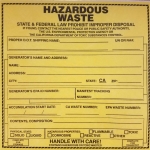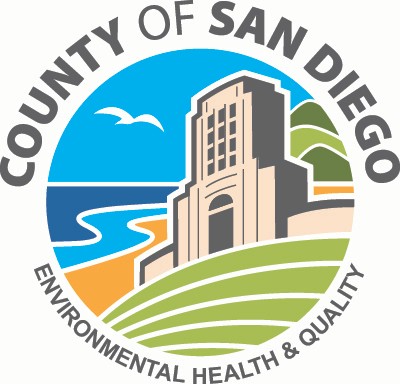Hazardous Waste Management
If your business has been identified as a generator of hazardous waste and/or universal waste, you must follow federal and state hazardous waste laws. The intent of these laws is to ensure that hazardous waste is properly managed to protect public health and the environment.
The Department of Environmental Health and Quality (DEHQ), Hazardous Materials Division (HMD) has been certified by the California Environmental Agency (CalEPA) as the local Certified Unified Program Agency (CUPA), and thus responsible for implementing these laws and regulations at the local level.
CERS Online Reporting Requirement
Generators of hazardous waste are required to report to their local regulator the hazardous waste they produce using the California Environmental Reporting System (CERS). This legal requirement to report was effective on January 1, 2013. For more information please visit our CERS Information page.
What is Hazardous Waste?
It is the generator’s responsibility to determine whether or not a waste must be stored, transported and disposed of as a hazardous waste because of it's toxicity, reactivity, ignitability or corrosivity. Often this determination can be made by knowledge of the process and materials used to generate the waste. However, questionable waste streams may need to be chemically or physically analyzed.
Learn
more about Hazardous Waste Determination
How Much Hazardous Waste Do You Generate?
Different regulations apply to hazardous waste generators depending on the amount of hazardous waste produced each month. Each generator class is subject to different regulations for employee training, training documentation and written contingency plans.
Learn more about hazardous waste generator classes
Do I need an EPA ID Number?
An EPA ID number is needed if you generate any amount of hazardous waste and for large quantity universal waste handler's (handling 5,000 kg or more of universal waste at one time).
Learn more about obtaining an EPA ID number
Hazardous Waste Storage and Labeling Requirements
Learn more about the minimum storage and labeling requirements for hazardous waste generators
Hazardous Waste Training Requirements
A personnel training program is required of all hazardous waste generators to ensure that employees are able to respond effectively to emergencies. All employees working with and around hazardous waste should be trained in emergency procedures, emergency equipment, and emergency systems.
Learn more about training requirements
Emergency Preparedness, Business Plan and Contingency Plan
Every hazardous waste generator is required to have an emergency contingency plan (business plan) designed to minimize hazards to human health and the environment from fires, explosions, or an unplanned release of hazardous waste to air, soil, or surface water. The plan shall be carried out immediately whenever a fire, explosion or unplanned chemical release occurs. All business plan forms are required to be submitted through CERS.
Learn more about emergency preparedness, required emergency equipment, and emergency procedures.
Proper Disposal of Hazardous Waste
Hazardous wastes must be disposed of only at State permitted treatment, storage or disposal facilities and may not be disposed of in the regular trash, onto the surface of the ground, or into the storm drain. In addition, they may not be dumped into the sewer system (i.e., a floor drain, sink, or toilet) unless you have an industrial waste discharge pretreatment permit from your local sewer agency for that specific waste, which was properly treated first before discharge.
Hazardous wastes must be transported only by California Registered Hazardous Waste Transporters to a State-permitted treatment, storage, or disposal facility (TSDF). These transporters are registered by the California Department of Toxic Substances Control and California Highway Patrol. Hazardous waste must be packaged and labeled for transport in accordance with applicable Department of Transportation regulations.
Waste Tracking and Manifest Requirements
Hazardous waste transported for disposal or treatment must be accompanied by a Uniform Hazardous Waste Manifest form. As a generator of hazardous waste, you are responsible and liable for the wastes you generate. Accurately completing a manifest form ensures that you will receive notice after the wastes have been delivered to the licensed hazardous waste facility. It also is required to meet your responsibility as a hazardous waste generator
Household Hazardous Waste Disposal Program for Small Businesses
Businesses that generate less than 27 gallons or 220 pounds of hazardous waste per month or less than one quart or 2.2 pounds of acutely hazardous waste (referred to as Conditionally Exempt Small Quantity Generators or CESQGs) may use the County’s Household Hazardous Waste Disposal Program for small businesses.
Hazardous Waste Treatment
If you wish to dispose of or treat your hazardous waste to render it less toxic or non-hazardous at your waste generator location, you must notify the department under the tiered permitting program 60 days before treating the hazardous waste and meet the eligibility and waste handling requirements. Treatment notification must be done using CERS.
Violations
Hazardous waste regulations are intended to prevent the mismanagement of hazardous waste which could lead to conditions that may cause harm to humans or to the environment. Since hazardous materials can cause serious or fatal injuries, penalties have been established for willful or negligent violation of the hazardous waste laws. Violations may result in monetary penalties for every day of violation and/or up to three years in a State prisonIf a facility disagrees with one or more of the violations, the facility can dispute the violation(s) by contacting HMD within 30 days of issuance of the violation.






